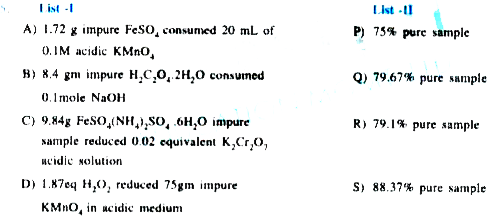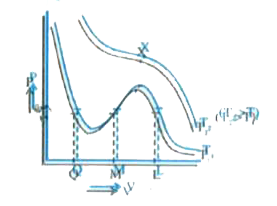Oleum is mixture of H2SO4 and SO3 i.e. H2S2O7 which is obtained by passing SO3 is solution of H2SO4. In order to dissolve SO3 in oleum, dilution of oleum is done by water in which oleum is converted into pure H2SO as shown below:
H2SO4+SO3+H2O→2H2SO4 (pure)
When 100 gm oleum is diluted with water then total mass of diluted oleum is known as percentage labelling in oleum.
For example: 109%H2SO4 labelling of oleum sample means that 109 gm pure H2SO4 is obtained on diluting 100 gm oleum with 9 gm H2O which dissolves al free SO3 in oleum.
If 109% H2SO4 labelled oleum, the percent of free SO3 and H2SO4 areSolution in Telugu
30%, 70%
40%, 60%
60%, 40%
15%, 85%
The correct Answer is:B
Step by step video, text & image solution for Oleum is mixture of H_(2)SO_(4) and SO_(3) i.e. H_(2)S_(2)O_(7) which is obtained by passing SO_(3) is solution of H_(2)SO_(4). In order to dissolve SO_(3) in oleum, dilution of oleum is done by water in which oleum is converted into pure H_(2)SO as shown below: H_(2)SO_(4)+SO_(3)+H_(2)Oto2H_(2)SO_(4) (pure) When 100 gm oleum is diluted with water then total mass of diluted oleum is known as percentage labelling in oleum. For example: 109% H_(2)SO_(4) labelling of oleum sample means that 109 gm pure H_(2)SO_(4) is obtained on diluting 100 gm oleum with 9 gm H_(2)O which dissolves al free SO_(3) in oleum. If 109% H_(2)SO_(4) labelled oleum, the percent of free SO_(3) and H_(2)SO_(4) are by Chemistry experts to help you in doubts & scoring excellent marks in Class 12 exams.
Updated on:21/07/2023Topper's Solved these Questions
- STOICHIOMETRYBOOK - AAKASH SERIESCHAPTER - STOICHIOMETRYEXERCISE - LECTURE SHEET ( EXERCISE III MATRIX MATCHING TYPE QUESTIONS)
2 Videos
- STOICHIOMETRYBOOK - AAKASH SERIESCHAPTER - STOICHIOMETRYEXERCISE - LECTURE SHEET ( EXERCISE III INTEGER TYPE QUESTIONS)
7 Videos
- STOICHIOMETRYBOOK - AAKASH SERIESCHAPTER - STOICHIOMETRYEXERCISE - LECTURE SHEET ( EXERCISE III MORE THAN ONE CORRECT ANSWER TYPE QUESTIONS)
4 Videos
- STATES OF MATTER BOOK - AAKASH SERIESCHAPTER - STATES OF MATTER EXERCISE - ADDITIONAL PRACTICE EXERCISE -PRACTICE SHEET (ADVANCED) (LINKED COMPREHENSION TYPE QUESTIONS) (PASSAGE- IV)
2 Videos
- SURFACE CHEMISTRYBOOK - AAKASH SERIESCHAPTER - SURFACE CHEMISTRYEXERCISE - Objective Excersice - 4 (ASSERTION (A)& REASON (R ) TYPE QUESTION)
34 Videos
Similar Questions

View SolutionWhat is mol. WtEq. wt of FeC2O4 getting converted into Fe+3 and CO2?
View SolutionCombustion of 2.24 its ethane at STP requires
View SolutionAt a particular temperature and pressure for a real gas Van der Waal's equation can be written as:
(P+aV2m)(Vm−b)=RT

where Vm is molar volume of gas. This is cubic equation in the variable Vm and therefore for any single value of P & T there should be 3 values of Vm. Which are shown in graph as Q, M and L.
As temperature is made to increase at a certain higher temperature the three values of Vm becomes identical. The temperature, pressure & molar volume at point X are called Tc, Pc & Vc for real gas. The compressibility factor in terms of Pc, Vc and T is called Zc.
The expression of Van dcr Waal's constant 'a' can be given as
View Solution(A) De-emulsification is a reverse process of emulsion formation
(R ) During de-emulsification , the emulsion breaks to give oil and water.
View SolutionThe percentage labelling (mixture of H_(2)SO_(4) and SO_(3)) refers to the total mass of pure H_(2)SO_(4) . The total amount of H_(2)SO_(4) found after adding calculated amount of water to 100 g oleum is the percentage labelling of oleum. The higher the percentage lebeling of oleum higher is the amount of free SO_(3) in the oleum sample. What is the amount of free SO_(3) in an oleum sample labelled as '118%'.
View SolutionThe percentage labelling (mixture of H_(2)SO_(4) and SO_(3)) refers to the total mass of pure H_(2)SO_(4) . The total amount of H_(2)SO_(4) found after adding calculated amount of water to 100 g oleum is the percentage labelling of oleum. The higher the percentage lebeling of oleum higher is the amount of free SO_(3) in the oleum sample. The percent free SO_(3) is an oleum is 20%. Label the sample of oleum in terms of percent H_(2) SO_(4) .
View SolutionCalculate the % of free SO3 in oleum ( a solution of SO3 in H2SO4) that is labelled 109%H2SO4 by weight.
View SolutionComprehension # 6
The percentage labelling of oleum is a unique process by means of which, the percentage composition of H2SO4,SO3 (free) and SO3 (combined) is calculated.
Oleum is nothing but it is a mixture of H2SO4 and SO3 i.e., H2S2O7, which is obtained by passing. SO3 in solution of H2SO4. In order of dissolve free SO3 in oleum, dilution of oleum is done, in which oleum converts into pure H2SO4. It is shown by the reaction as under :
H2SO4+SO3+H2O→2H2SO4(pure)
or " "SO3+H2O→H2SO4(pure)
When 100g sample of oleum is diluted with desired weight of H2O(ing), then the total mass of pure H2SO4 obtained after dilution is known as percentage labelling in oleum.
For example, if the oleum sample is labelled as 109%H2SO4 it means that 100g of oleum on dilution with 9m of H2O provides 109g pure H2SO4, in which all free SO2 in 100g of oleum is dissolved.
In the above question number 1, what is the percentage of free SO3 and H2SO4 in the oleum simple respectively ?
View SolutionComprehension # 6 The percentage labelling of oleum is a unique process by means of which, the percentage composition of H_(2)SO_(4), SO_(3) (free) and SO_(3) (combined) is calculated. Oleum is nothing but it is a mixture of H_(2)SO_(4) and SO_(3) i.e., H_(2)S_(2)O_(7) , which is obtained by passing. SO_(3) in solution of H_(2)SO_(4) . In order of dissolve free SO_(3) in oleum, dilution of oleum is done, in which oleum converts into pure H_(2)SO_(4) . It is shown by the reaction as under : H_(2)SO_(4)+SO_(3)+H_(2)Orarr2H_(2)SO_(4)("pure") or " " SO_(3)+H_(2)OrarrH_(2)SO_(4)("pure") When 100g sample of oleum is diluted with desired weight of H_(2)O ("in" g) , then the total mass of pure H_(2)SO_(4) obtained after dilution is known as percentage labelling in oleum. For example, if the oleum sample is labelled as ""109%H_(2)SO_(4)" it means that 100 g of oleum on dilution with 9m of H_(2)O provides 109g pure H_(2)SO_(4) , in which all free SO_(2) in 100g of oleum is dissolved. In the above question number 1 , what will be the percentage of combined SO_(3) in the given oleum sample?
View SolutionComprehension # 6 The percentage labelling of oleum is a unique process by means of which, the percentage composition of H_(2)SO_(4), SO_(3) (free) and SO_(3) (combined) is calculated. Oleum is nothing but it is a mixture of H_(2)SO_(4) and SO_(3) i.e., H_(2)S_(2)O_(7) , which is obtained by passing. SO_(3) in solution of H_(2)SO_(4) . In order of dissolve free SO_(3) in oleum, dilution of oleum is done, in which oleum converts into pure H_(2)SO_(4) . It is shown by the reaction as under : H_(2)SO_(4)+SO_(3)+H_(2)Orarr2H_(2)SO_(4)("pure") or " " SO_(3)+H_(2)OrarrH_(2)SO_(4)("pure") When 100g sample of oleum is diluted with desired weight of H_(2)O("in" g) , then the total mass of pure H_(2)SO_(4) obtained after dilution is known as percentage labelling in oleum. For example, if the oleum sample is labelled as ""109%H_(2)SO_(4)" it means that 100 g of oleum on dilution with 9m of H_(2)O provides 109g pure H_(2)SO_(4) , in which all free SO_(2) in 100g of oleum is dissolved. What volume of 10 M NaOH ("in" mL) will be required to react completely with free SO_(3) in 118% labelled oleum sample?
View SolutionComprehension # 6
The percentage labelling of oleum is a unique process by means of which, the percentage composition of H2SO4,SO3 (free) and SO3 (combined) is calculated.
Oleum is nothing but it is a mixture of H2SO4 and SO3 i.e., H2S2O7, which is obtained by passing. SO3 in solution of H2SO4. In order of dissolve free SO3 in oleum, dilution of oleum is done, in which oleum converts into pure H2SO4. It is shown by the reaction as under :
H2SO4+SO3+H2O→2H2SO4(pure)
or " "SO3+H2O→H2SO4(pure)
When 100g sample of oleum is diluted with desired weight of H2O(ing), then the total mass of pure H2SO4 obtained after dilution is known as percentage labelling in oleum.
For example, if the oleum sample is labelled as 109%H2SO4 it means that 100g of oleum on dilution with 9m of H2O provides 109g pure H2SO4, in which all free SO2 in 100g of oleum is dissolved.
For 118%H2SO4 labelled oleum, if the number of moles of free SO3, number of moles of H2SO4 and number of moles of H2O be x, y and z respectively, then what will be value x+y+z ?
View SolutionComprehension # 7
Oleum is considered as a solution of SO3 in H2SO4, which is obtained by passing SO3 in solution of H2SO4. When 100g sample of oleum is diluted with desired weight of H2O then the total mass of H2SO4 obtained after dilution is known as % labelling in oleum.
For example, a oleum bottle labelled as 109%H2SO4 means the 109g total mass of pure H2SO4 will be formed when 100g of oleum is diluted by 9g of H2O which combines combines with all the free SO3 present in oleum to form H2SO4 as SO3+H2O→H2SO4
9.0g water is added into 100g oleum sample labelled as 112%H2SO4 then the amount of free SO3 remaining in the solution is :
View SolutionComprehension # 7 Oleum is considered as a solution of SO_(3) in H_(2)SO_(4) , which is obtained by passing SO_(3) in solution of H_(2)SO_(4) . When 100g sample of oleum is diluted with desired weight of H_(2)O then the total mass of H_(2)SO_(4) obtained after dilution is known as % labelling in oleum. For example, a oleum bottle labelled as 109% H_(2)SO_(4) means the 109g total mass of pure H_(2)SO_(4) will be formed when 100g of oleum is diluted by 9g of H_(2)O which combines combines with all the free SO_(3) present in oleum to form H_(2)SO_(4) as SO_(3)+H_(2)OrarrH_(2)SO_(4) 1 g of oleum sample is diluted with water. The solution required 54 mL of 0.4 N NaOH for complete neutralization. The % of free SO_(3) in the sample is :
View SolutionOleum is considered as a solution of SO_(3) in H_(2)SO_(4) , which is obtained by passing SO_(3) in solution of H_(2)SO_(4) When 100 g sample of oleum is diluted with desired mass of H_(2)O then the total mass of H_(2)SO_(4) obtained after dilution is known is known as % labelling in oleum. For example, a oleum bottle labelled as ' 019% H_(2)SO_(4) ' means the 109 g total mass of pure H_(2)SO_(4) will be formed when 100 g of oleum is diluted by 9 g of H_(2)O which combines with all the free SO_(3) present in oleum to form H_(2)SO_(4) as SO_(3)+H_(2)O to H_(2)SO_(4) What is the % of free SO_(3) in an oleum that is labelled as '104.5% H_(2)SO_(4)' ?
View Solution
